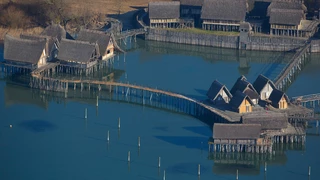Prehistoric Pile Dwellings
around Lake Constance
UNESCO World Heritage: Prehistoric Pile Dwellings around the Alps
The name „stilt house or pile dwelling“ is used to describe archaeological remains discovered along alpine lake shorelines. These homes and villages once stood on raised stilts over the water around the 4-country region of Lake Constance. In the Upper Swabian bogs, we have discovered ground level settlements as well as "raised" stilt houses. The World Heritage Committee declared "Prehistoric Pile Dwellings around the Alps," (including Lake Constance and Upper Swabia) the universal heritage of humanity on June 27, 2011.
Sites Overview
111 sites around the Four-country Lake Constance region belong to the UNESCO World Heritage Site
"Prehistoric Pile Dwellings around the Alps," as shown in the map overview.
Museums, Exhibitions & Co.
Many UNESCO sites are inaccessible to visitors since they are underwater or buried in wet moorland. For this reason, Lake Constance
museums are the repository of artifacts and information. They offer the public a wide selection of discoveries with
fascinating open-air reconstructions and information boards around the region.
Contact Information
(D) Pfahlbauten-Informationszentrum Baden-Württemberg
Tel.: +49 7735 93 77 7118 | Mail: pfahlbauten@rps.bwl.de
(D) Bayerisches Landesamt für Denkmalpflege
Tel.: +49 89 210140 73 | Mail: markus.gschwind@blfd.bayern.de
(CH) Swiss Coordination Group UNESCO Palafittes
Tel.: +41 61 261 30 91 | E-Mail:
info@palafittes.org
(AT) Kuratorium Pfahlbauten
Tel.: +43 (0)664 88672334 | E-Mail: info@pfahlbauten.at











